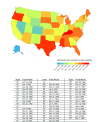Fifty Years of Influenza A(H3N2) Following the Pandemic of 1968 - PubMed (original) (raw)
Fifty Years of Influenza A(H3N2) Following the Pandemic of 1968
Barbara J Jester et al. Am J Public Health. 2020 May.
Abstract
In 2018, the world commemorated the centennial of the 1918 influenza A(H1N1) pandemic, the deadliest pandemic in recorded history; however, little mention was made of the 50th anniversary of the 1968 A(H3N2) pandemic. Although pandemic morbidity and mortality were much lower in 1968 than in 1918, influenza A(H3N2) virus infections have become the leading cause of seasonal influenza illness and death over the last 50 years, with more than twice the number of hospitalizations from A(H3N2) as from A(H1N1) during the past six seasons. We review the emergence, progression, clinical course, etiology, epidemiology, and treatment of the 1968 pandemic and highlight the short- and long-term impact associated with A(H3N2) viruses. The 1968 H3N2 pandemic and its ongoing sequelae underscore the need for improved seasonal and pandemic influenza prevention, control, preparedness, and response efforts.
Figures
FIGURE 1—
Peak Week of Pandemic Influenza Activity, United States, 1968 Influenza A(H3N2) Pandemic Source. National Center for Communicable Diseases. Influenza—Respiratory Diseases Surveillance. National Communicable Disease Center, June 30, 1969. Report No.: 85.
FIGURE 2—
Estimated Influenza-Like Illness and Vaccine Availability, United States, 1968 Influenza A(H3N2) Pandemic Source. Influenza-like estimates are from the Department of Health Education and Welfare, “Acute Conditions.” Vaccine availability is from Murray, “Production and Testing in the USA of Influenza Virus Vaccine.”
Similar articles
- Incidence of medically attended influenza during pandemic and post-pandemic seasons through the Influenza Incidence Surveillance Project, 2009-13.
Fowlkes A, Steffens A, Temte J, Lonardo SD, McHugh L, Martin K, Rubino H, Feist M, Davis C, Selzer C, Lojo J, Oni O, Kurkjian K, Thomas A, Boulton R, Bryan N, Lynfield R, Biggerstaff M, Finelli L; Influenza Incidence Surveillance Project Working Group. Fowlkes A, et al. Lancet Respir Med. 2015 Sep;3(9):709-718. doi: 10.1016/S2213-2600(15)00278-7. Epub 2015 Aug 21. Lancet Respir Med. 2015. PMID: 26300111 Free PMC article. - Pandemic influenza 1918 H1N1 and 1968 H3N2 DNA vaccines induce cross-reactive immunity in ferrets against infection with viruses drifted for decades.
Bragstad K, Martel CJ, Thomsen JS, Jensen KL, Nielsen LP, Aasted B, Fomsgaard A. Bragstad K, et al. Influenza Other Respir Viruses. 2011 Jan;5(1):13-23. doi: 10.1111/j.1750-2659.2010.00177.x. Epub 2010 Nov 3. Influenza Other Respir Viruses. 2011. PMID: 21138536 Free PMC article. - Comparison between virus shedding and fever duration after treating children with pandemic A H1N1/09 and children with A H3N2 with a neuraminidase inhibitor.
Sugaya N, Sakai-Tagawa Y, Bamba M, Yasuhara R, Yamazaki M, Kawakami C, Yamaguchi Y, Ide Y, Ichikawa M, Mitamura K, Kawaoka Y. Sugaya N, et al. Antivir Ther. 2015;20(1):49-55. doi: 10.3851/IMP2798. Epub 2014 May 16. Antivir Ther. 2015. PMID: 24832015 - Pandemic novel 2009 H1N1 influenza: what have we learned?
LaRussa P. LaRussa P. Semin Respir Crit Care Med. 2011 Aug;32(4):393-9. doi: 10.1055/s-0031-1283279. Epub 2011 Aug 19. Semin Respir Crit Care Med. 2011. PMID: 21858744 Review. - The 2009 influenza A (H1N1) pandemic: what have we learned in the past 6 months.
del Rio C, Guarner J. del Rio C, et al. Trans Am Clin Climatol Assoc. 2010;121:128-37; discussion 138-40. Trans Am Clin Climatol Assoc. 2010. PMID: 20697556 Free PMC article. Review.
Cited by
- Potential antiviral activity of rhamnocitrin against influenza virus H3N2 by inhibiting cGAS/STING pathway in vitro.
Chen Z, Wang W, Zeng K, Zhu J, Wang X, Huang W. Chen Z, et al. Sci Rep. 2024 Nov 16;14(1):28287. doi: 10.1038/s41598-024-79788-z. Sci Rep. 2024. PMID: 39550441 Free PMC article. - Immunity and Protective Efficacy of a Plant-Based Tobacco Mosaic Virus-like Nanoparticle Vaccine against Influenza a Virus in Mice.
Madapong A, Petro-Turnquist EM, Webby RJ, McCormick AA, Weaver EA. Madapong A, et al. Vaccines (Basel). 2024 Sep 26;12(10):1100. doi: 10.3390/vaccines12101100. Vaccines (Basel). 2024. PMID: 39460267 Free PMC article. - Whole-genome analysis of circulating influenza A virus (H3N2) strains in Shanghai, China from 2005 to 2023.
Zhao X, Gu Y, Tang X, Jiang C, Fang F, Chu W, Tao L, Zhang X, Chen M, Wu H, Xie Y, Liu J, Teng Z. Zhao X, et al. Emerg Microbes Infect. 2024 Dec;13(1):2396867. doi: 10.1080/22221751.2024.2396867. Epub 2024 Sep 5. Emerg Microbes Infect. 2024. PMID: 39193626 Free PMC article. - Enhancing the use of T cells as a universal preventive measure against H3N2 influenza: Mechanism and implications.
Bhatt JH, Kagathara N, Mehta K, Joshi M, Omar MA. Bhatt JH, et al. Health Sci Rep. 2024 Aug 20;7(8):e70004. doi: 10.1002/hsr2.70004. eCollection 2024 Aug. Health Sci Rep. 2024. PMID: 39170886 Free PMC article. No abstract available. - The V223I substitution in hemagglutinin reduces the binding affinity to human-type receptors while enhancing the thermal stability of the H3N2 canine influenza virus.
Liu L, Wang F, Wu Y, Mi W, Zhang Y, Chen L, Wang D, Deng G, Shi J, Chen H, Kong H. Liu L, et al. Front Microbiol. 2024 Jul 22;15:1442163. doi: 10.3389/fmicb.2024.1442163. eCollection 2024. Front Microbiol. 2024. PMID: 39104583 Free PMC article.
References
- Chang, “National Influenza Experience.”.
- Cockburn et al., “Origin and Progress.”.
- Ibid.
MeSH terms
Substances
LinkOut - more resources
Full Text Sources
Medical
Miscellaneous

